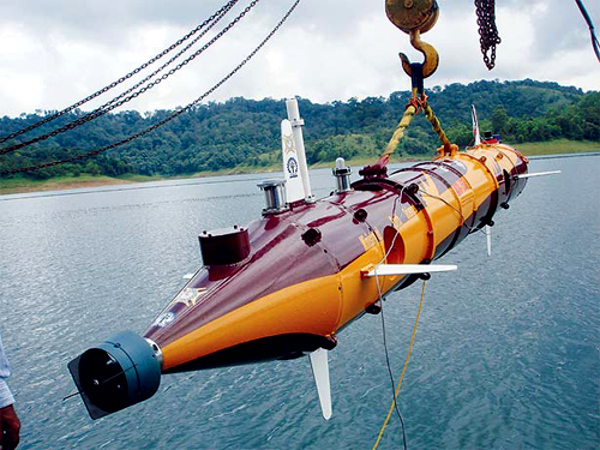Indian Navy at all times maintains a well-trained diving team which is always under deployment onboard warships. According to a senior naval officer who wished to remain anonymous, “Naval divers are highly trained in handling underwater explosives and other covert activities. Onboard a warship, a divers’ complement plays an active role in fleet-level mission planning. For any combat or commercial underwater activities, the cost of a diver is very high, and includes adequate risk compensation in his emoluments.”
For commercial and military applications, the underwater environment has always been a risky zone for human activities.
“The training and upkeep of diver and diving equipment for the navy is a long term and an expensive gambit, even though the divers are usually volunteered from the main complement of the ships and submarines. They undergo a rigorous and tough training regime and pass percentage is usually on the lower side,” explained the naval officer.
Remotely Operated Vehicle (ROVs)
“During diving operations, in order to support or as a substitute to the underwater teams, specialized underwater electrically operated Remotely Operated Vehicle (ROVs) is also utilized. ROVs are operated through an umbilical cable Control Unit fitted onboard the mother ship. This tether link between the ROV and Tether Management System onboard the Ship is mainly formed by a group of armoured cables comprising of separate cable each for electrical power, control signals, and fibre optics (for data and video signals),” explains Milind Kulshreshtha, C4I expert.
According to the C4I expert, “The primary applications of naval ROVs are mainly for underwater hull inspection, and explosive ordnance disposal (EOD), as a stand-in for detecting and disarming an explosive. ROVs also can be used for special operations like detection of enemy submarines and the Search & Rescue (SAR) role. ROVs provide for a long underwater submerged capability and, with the manipulator arm fitted, can exert a strong force to pull or manipulate an object. With specialized payloads, ROVs can assist in the Submarine rescue missions also, and Indian Navy’s Deep Sea Rescue Vessel (DSRV) operates one to assist in submarine rescue role.”
Unmanned Aerial Vehicle
An Unmanned Aerial Vehicle (UAV) comprises of two standard configurations viz. a fixed-wing (with aeroplane like wings) or a Rotary configuration (with helicopter-like propellers). Indian Navy has always preferred fixed-wing UAVs due to its capability as a sensor-operating platform in a hostile environment of the battlefield. It is also a cost-effective peacetime Intelligence gathering tool. The first batch of naval drones introduced was Israeli make ‘Heron’ and ‘Searcher’ UAVs.
“Indian Navy created a new dedicated Air Squadron for operating these UAVs as part of maritime reconnaissance role in various theatres of operations. The Naval Squadron was designed for coast-based ‘launch and recovery’ of these UAVs, with UAV Direction commands from the ships and they typically carried a payload of Electro-optic camera and COMINT (Communication Intelligence) equipment,” Kulshreshtha says.
Adding, “Heron is the longer endurance UAVs with provision for fitment of a maritime radar payload for enhanced surveillance roles. Naval UAVs can further provide the Target Tracking and Target Designation (TD) coordinates to facilitate ship-based suitable weapon launch. These UAVs are capable of OTHT (Over the Horizon Target) data transmission, accomplish SAR (Search & Rescue) missions and provide Battle damage assessment to the Fleet Commander at sea.”
As has been reported by Financial Express Online, later this year the Indian Navy for maritime surveillance will procure 10 Sea Guardian High Altitude Long Endurance (HALE) armed drones from the US-based General Atomics.
With COMCASA (Communications Compatibility and Security Agreement), these UAVs can assist in inter-operability and joint surveillance/Intelligence gathering activities.
Plans for the third aircraft carrier and submarines remain alive
Despite the constraints the plans for the third aircraft carrier, submarines under Project 75I remain.
While the liabilities for the Indian Navy stand at Rs 45,000 crore, in the capital budget allocation for 2020-21, it has got Rs 26,688 crore.
For 2019-20 the Navy’s capital allocation was Rs 23,156 crore and the liabilities were Rs 25,461 crore.
In its fleet rationalisation plan, according to a senior naval officer, “Due to the shortage of funds, the Navy has cut down its plans to get twelve minesweepers to eight and additional P-8I long-range patrol aircraft from 10 to six.”
“Since the Navy has no dedicated minesweepers it has adopted other measures and to ensure the safety of the Indian waters has acquired some autonomous underwater vehicles, and has plans to get more.”
India’s first-ever Chief of Defence Staff Gen Bipin Rawat had in a media interaction has suggested a staggered approach to big procurements.
The Indian Navy has proposed a second Indigenous Aircraft Carrier (IAC-II) which will cost Rs 45,000 crore, displacing 65,000 tonnes and conventionally powered. It will have a steam-launched catapult for launching and recovering aircraft.
Source: FE
Image Courtesy: IDRW
You may also like
-
IAF Aircraft Set Course For Exercise Eastern Bridge VII At Oman
-
IAF Set To Host The Indian Defence Aviation Exposition-II At Jodhpur
-
Defence Secretary to co-chair 5th India-Philippines Joint Defence Cooperation Committee meeting in Manila
-
Simultaneous Launch Of ‘malpe And Mulki’, Fourth And Fifth Ships Of Asw Swc (Csl) Project
-
Aatmanirbharta in Defence: MoD signs Contract with HAL for 240 AL-31FP Aero Engines for Su-30MKI Aircraft
